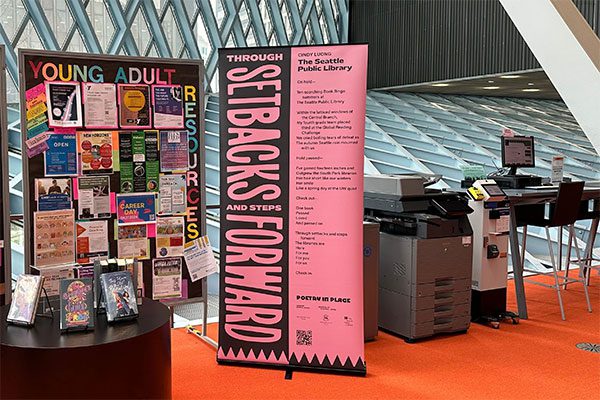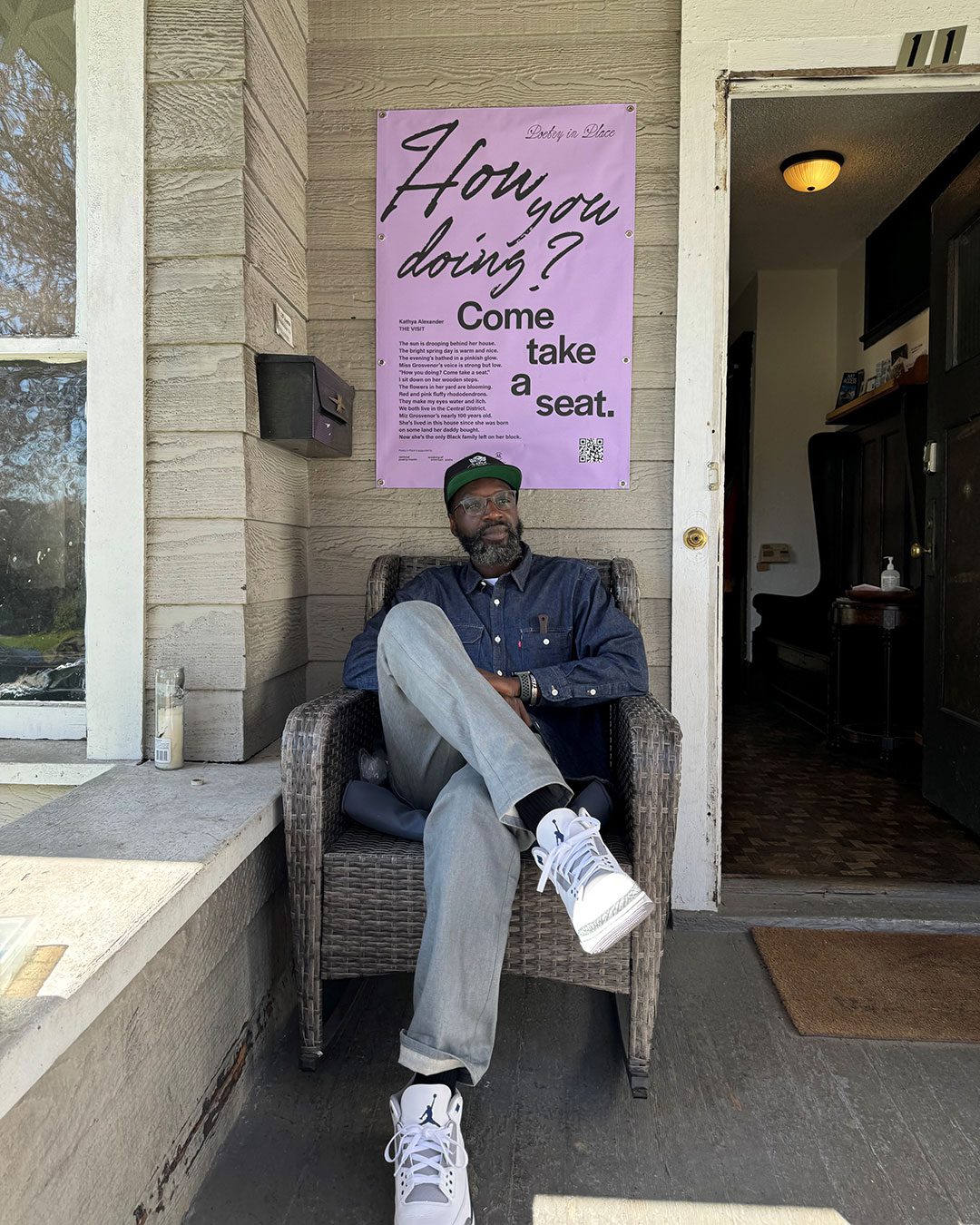
 In order to bring the public into my Center City Public Art Plan process I have been leading walks through downtown with various themes. On April 23rd and May 7th I led a “tree trek” where, along with my guests Kelly Pajek (public Art Project Manager, 4Culture) and Jim Dememtre (Arts writer/Botanist), we discussed urban “arbortecture” or the planning, designing, and use of trees and other botanicals in the city space.
In order to bring the public into my Center City Public Art Plan process I have been leading walks through downtown with various themes. On April 23rd and May 7th I led a “tree trek” where, along with my guests Kelly Pajek (public Art Project Manager, 4Culture) and Jim Dememtre (Arts writer/Botanist), we discussed urban “arbortecture” or the planning, designing, and use of trees and other botanicals in the city space.
For this trek I wove together stories of social justice (and injustice), public art, city planning, public/private space, and moments for the participants to offer their own ideas for the future of downtown, using urban forestry as a jumping off point.
 We began our walk at Pilgrim Pillars Park on the corner of Pike and Boren where I spoke about the once-forested Duwamish land we now call Seattle, the history of architectural columns, the history and legacy of redlining in Seattle, Pilgrim Pillars itself, and why its location – facing the gaping maw of I-5 – is particularly significant. We then spent time each discussing and offering suggestions regarding how the park might be used and what could make it a more vibrant and people-friendly place.
We began our walk at Pilgrim Pillars Park on the corner of Pike and Boren where I spoke about the once-forested Duwamish land we now call Seattle, the history of architectural columns, the history and legacy of redlining in Seattle, Pilgrim Pillars itself, and why its location – facing the gaping maw of I-5 – is particularly significant. We then spent time each discussing and offering suggestions regarding how the park might be used and what could make it a more vibrant and people-friendly place.
 From there we walked to Freeway Park. At this location we discussed the Babylonian Hanging Gardens, brutalist architecture, and the history and design of Freeway Park itself. Jim Demetre introduced us to particularly special tree specimens and then showed us the little know portal that looks onto the highway from behind the falls.
From there we walked to Freeway Park. At this location we discussed the Babylonian Hanging Gardens, brutalist architecture, and the history and design of Freeway Park itself. Jim Demetre introduced us to particularly special tree specimens and then showed us the little know portal that looks onto the highway from behind the falls.
From Freeway Park, Kelly Pajek led us to the Tree Grate Museum at Ninth Avenue and Pike Street. The Tree Grates (artist-designed cast metal grates at the base of Linden, Oak, Gingko, Zelkova, and Maple trees) were part of a public art scheme created in the late 80’s as a way to integrate artists into urban design and city planning. Kelly discussed the design and way-finding function of the grates, why tree grates have fallen out of favor, and what that means for this iconic element of Seattle’s urban art experience.
 After the tree grates we headed to the Amazon Spheres at Sixth Avenue and Lenora Avenue. Once completed, these three intersecting glass and steel hemispheres will be a super-deluxe, private, botanical garden (complete with exotic plant specimens, waterfalls, and tree houses) for Amazon employees. We spoke about the idea of the “hot house flower” and conducted a quick group action/ritual at the site regarding the necessity of self-care and being “high maintenance.”
After the tree grates we headed to the Amazon Spheres at Sixth Avenue and Lenora Avenue. Once completed, these three intersecting glass and steel hemispheres will be a super-deluxe, private, botanical garden (complete with exotic plant specimens, waterfalls, and tree houses) for Amazon employees. We spoke about the idea of the “hot house flower” and conducted a quick group action/ritual at the site regarding the necessity of self-care and being “high maintenance.”
Our next stop was to view and discuss examples of “Leaves of Remembrance” on Third and Lenora Avenues. These brass leaves, embedded into the sidewalks throughout downtown, are a part of the Tree of Life (Homeless Remembrance Project) by Clark Wiegman, Karen Kiest, and Kim Lokan, 2012, sited at Victor Steinbrueck Park. They bear the names of homeless women and men who have died, “so that every person will have a place to be remembered.”
 From these small leaves we traveled on to the biggest tree downtown, the Giant Sequoia on Stewart Street between Third and Fourth Avenues. At this location I discussed plant intelligence, Sequoias in particular, and this tree specifically. We momentarily considered making this poor lonely tree a Tinder page, but decided to hug it instead. We then each offered up a “big idea” for downtown. Many of our ideas involved methods for reconnecting Center City Seattle back to nature. One of my favorites was the proposal to dig up a portion of the streets next to the bike lane, plant enough trees so that a durable canopy formed, thereby giving bike riders a drier pedaling corridor.
From these small leaves we traveled on to the biggest tree downtown, the Giant Sequoia on Stewart Street between Third and Fourth Avenues. At this location I discussed plant intelligence, Sequoias in particular, and this tree specifically. We momentarily considered making this poor lonely tree a Tinder page, but decided to hug it instead. We then each offered up a “big idea” for downtown. Many of our ideas involved methods for reconnecting Center City Seattle back to nature. One of my favorites was the proposal to dig up a portion of the streets next to the bike lane, plant enough trees so that a durable canopy formed, thereby giving bike riders a drier pedaling corridor.
The group’s next stop was to New Archetypes, by Anne and Patrick Poirier, 1990. At this sculpture I tied together the themes I laid out at Pilgrims Pillar Park. I read a particularly prescient quote from the Poirier’s regarding cultural memory, spoke about the construction site across the street (the soon to be built so- called 2&U building), and the architect’s use of tree-like pylons that they hope will be reminiscent of a Pacific Northwest forest.
 Our final stop of the day was to the roof top garden on the 17th floor of the Russell Investment building. The outing on April 23rd was marked by non-stop rain. The weather on May 7th however was ideal and our time spent at this avian garden was perfect. Jim spoke about the selected plant specimens (those typically found near the shore). At this elevation we were able to form a clearer understanding of the city streets (particularly near the market). We also began to notice just how many private, rooftop gardens Seattle has while at pedestrian level the city generally lacks significant green space.
Our final stop of the day was to the roof top garden on the 17th floor of the Russell Investment building. The outing on April 23rd was marked by non-stop rain. The weather on May 7th however was ideal and our time spent at this avian garden was perfect. Jim spoke about the selected plant specimens (those typically found near the shore). At this elevation we were able to form a clearer understanding of the city streets (particularly near the market). We also began to notice just how many private, rooftop gardens Seattle has while at pedestrian level the city generally lacks significant green space.
 I will be leading at least one more public walk through downtown before the end of my residency with the Office of Arts & Culture and Seattle Department of Transportation and I hope you can join me. These walks have been a great way for me to connect not only with how the public views downtown but to our shared experience of the city, together.
I will be leading at least one more public walk through downtown before the end of my residency with the Office of Arts & Culture and Seattle Department of Transportation and I hope you can join me. These walks have been a great way for me to connect not only with how the public views downtown but to our shared experience of the city, together.


